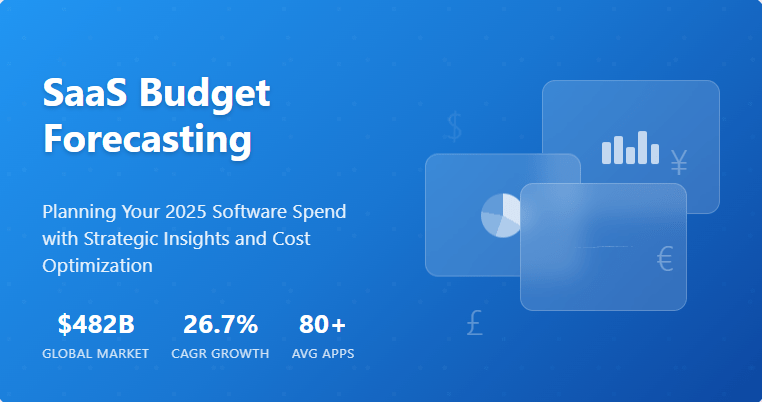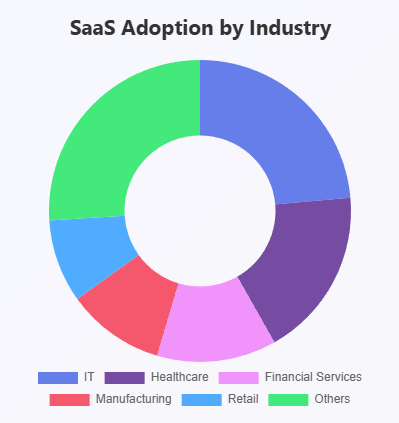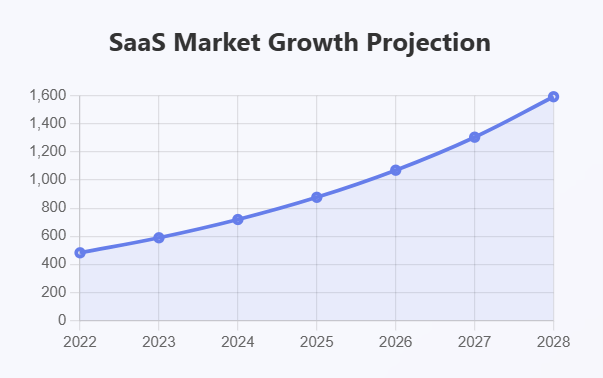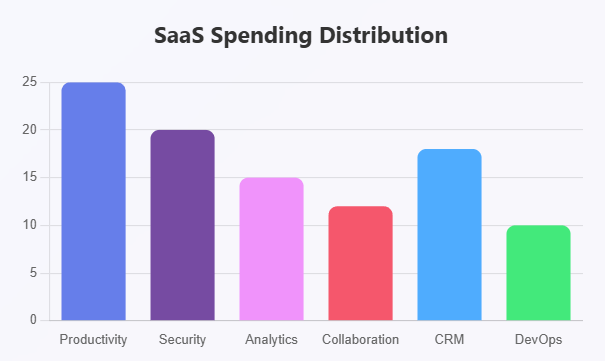
As organizations increasingly rely on Software as a Service (SaaS) solutions to drive their operations, the complexity of managing software spending has grown exponentially. With businesses using an average of 80+ SaaS applications, creating an accurate budget forecast for 2025 requires strategic planning, comprehensive visibility, and robust management practices.
SaaS budget forecasting goes beyond simple expense tracking—it’s a strategic process that aligns software investments with business objectives while ensuring cost efficiency and operational excellence. This comprehensive guide will equip you with the knowledge and strategies needed to create an effective SaaS budget forecast for 2025, helping your organization optimize spending while maximizing the value of your software investments.
What is SaaS Budget Forecasting?
SaaS budget forecasting is the strategic process of estimating and planning your organization’s software-as-a-service expenditures for a specific period, typically the upcoming fiscal year. This process involves analyzing historical spending patterns, predicting future software needs, and establishing spending limits that align with business growth objectives and financial constraints.
Unlike traditional software budgeting, which involved one-time license purchases, SaaS budget forecasting must account for recurring subscription costs, variable user counts, feature upgrades, and the dynamic nature of cloud-based software consumption. This approach requires continuous monitoring and adjustment as business needs evolve throughout the year.
Effective SaaS budget forecasting encompasses several critical elements: current subscription inventory, usage analytics, renewal dates, growth projections, and cost optimization opportunities. By integrating these components, organizations can create realistic budget forecasts that prevent overspending while ensuring adequate software resources to support business operations.

The Current State of SaaS Spending
The SaaS market has experienced remarkable growth, with global spending reaching $482 billion in 2022, representing a 21.7% increase from the previous year. This trend shows no signs of slowing, with MarketsandMarkets projecting the global SaaS market to grow at a compound annual growth rate of 26.7% through 2028.
Organizations across industries are embracing SaaS solutions for their scalability, accessibility, and cost-effectiveness compared to traditional on-premises software. However, this widespread adoption has created new challenges in budget management and spend visibility. Many companies struggle with shadow IT, where employees independently subscribe to SaaS tools without proper oversight, leading to duplicate licenses, unused subscriptions, and budget overruns.
The average enterprise now manages hundreds of SaaS subscriptions across multiple departments, making it increasingly difficult to maintain accurate budget forecasts without proper tools and processes. Research indicates that organizations typically waste 30-40% of their SaaS spending on unused or underutilized licenses, highlighting the critical importance of effective budget forecasting and management.
Recent economic uncertainties have further emphasized the need for precise SaaS budget forecasting, as organizations seek to optimize their software investments while maintaining operational efficiency. Companies are increasingly recognizing that effective SaaS budget management can significantly impact their bottom line and competitive advantage.
Key Components of Effective SaaS Budget Planning
Comprehensive Software Inventory
The foundation of successful SaaS budget forecasting begins with creating a complete inventory of all software subscriptions across your organization. This inventory should include officially sanctioned applications as well as shadow IT solutions that departments may have adopted independently.
Your software inventory should capture essential details for each application: subscription costs, billing cycles, user counts, renewal dates, usage metrics, and business criticality. This comprehensive view enables accurate budget projections and identifies opportunities for cost optimization through consolidation or elimination of redundant tools.
Regular inventory audits are crucial, as the SaaS landscape within organizations changes frequently. New tools are adopted, existing subscriptions are modified, and business requirements evolve, making it essential to maintain an up-to-date understanding of your software portfolio.
Usage Analytics and Performance Metrics
Understanding how your organization actually uses SaaS applications is crucial for accurate budget forecasting. Usage analytics provide insights into which tools deliver value and which may be candidates for downsizing or elimination.
Key metrics to track include active user counts, feature utilization rates, login frequencies, and business outcome correlations. These metrics help justify software investments and identify optimization opportunities, such as rightsizing subscriptions based on actual usage patterns rather than initial estimates.
Performance metrics should also consider business impact, measuring how each SaaS application contributes to productivity, revenue generation, or operational efficiency. This data supports informed decision-making when allocating budget resources across different software categories.
Renewal Calendar Management
SaaS subscriptions operate on various billing cycles, from monthly to multi-year commitments, making renewal tracking essential for budget forecasting. A comprehensive renewal calendar helps prevent surprise expenses and enables strategic timing of contract negotiations.
Your renewal calendar should include contract terms, auto-renewal clauses, notice requirements, and negotiation opportunities. This visibility allows for proactive budget planning and ensures adequate time for vendor negotiations or alternative solution evaluations.
Strategic renewal management can significantly impact your budget forecast, as contract negotiations often present opportunities for volume discounts, extended payment terms, or feature upgrades that affect overall spending projections.

Steps to Create Your 2025 SaaS Budget Forecast
Step 1: Assess Current SaaS Spending
Begin your 2025 budget forecasting process by thoroughly analyzing your current SaaS spending patterns. Collect data from all payment sources, including corporate credit cards, accounts payable systems, and departmental budgets to create a complete spending baseline.
Categorize expenses by software type, department, business function, and cost structure to identify spending patterns and trends. This analysis reveals areas of high expenditure, potential redundancies, and opportunities for negotiation or consolidation.
Document subscription details including current pricing, user counts, contract terms, and renewal dates. This information forms the foundation for projecting future costs and identifying budget optimization opportunities.
Step 2: Evaluate Business Growth and Requirements
Your 2025 SaaS budget must align with anticipated business growth and changing operational requirements. Consider factors such as headcount projections, new market expansion, product launches, and strategic initiatives that may impact software needs.
Engage with department heads and business leaders to understand their 2025 objectives and potential software requirements. This collaborative approach ensures your budget forecast accounts for both known needs and anticipated growth scenarios.
Factor in seasonal variations, project-based software needs, and potential business model changes that could affect your SaaS requirements throughout 2025. This comprehensive planning approach prevents budget shortfalls and ensures adequate resources for business growth.
Step 3: Identify Cost Optimization Opportunities
Before finalizing your 2025 budget forecast, identify opportunities to optimize your current SaaS spending. Analyze usage data to identify underutilized subscriptions, duplicate applications, or oversized plans that could be rightsized or eliminated.
Consider consolidation opportunities where multiple tools could be replaced by comprehensive platforms offering similar functionality. Evaluate vendor relationships for negotiation potential, especially for high-value contracts approaching renewal.
Review contract terms for optimization opportunities such as annual vs. monthly billing discounts, multi-year commitments, or volume pricing tiers that could reduce overall costs while maintaining necessary functionality.
Step 4: Build Scenario-Based Projections
Create multiple budget scenarios to account for different business conditions and growth trajectories. Develop conservative, moderate, and aggressive growth scenarios that reflect potential business outcomes and their impact on software requirements.
Your conservative scenario should account for minimal growth with focus on cost optimization and efficiency improvements. The moderate scenario should reflect expected business growth with proportional software scaling. The aggressive scenario should account for rapid expansion requiring significant software investment.
These scenario-based projections provide flexibility in budget planning and enable rapid adjustment as business conditions change throughout 2025.
Step 5: Establish Governance and Approval Processes
Implement governance processes that ensure your 2025 SaaS budget remains on track throughout the year. Establish approval workflows for new software purchases, subscription changes, and budget modifications that require stakeholder review.
Create spending thresholds that trigger different levels of approval, from departmental authorization for small purchases to executive approval for significant software investments. These processes prevent unauthorized spending and maintain budget discipline.
Develop regular review schedules to monitor actual spending against budget forecasts, enabling proactive adjustments when necessary to maintain financial discipline and optimize software investments.

Common SaaS Budget Forecasting Challenges
Shadow IT and Untracked Spending
One of the most significant challenges in SaaS budget forecasting is the prevalence of shadow IT, where employees or departments independently subscribe to software tools without proper oversight. This unauthorized spending can significantly impact budget accuracy and create security risks.
Shadow IT often emerges when approved software solutions don’t meet specific departmental needs or when procurement processes are too slow or complex. While this can improve productivity in the short term, it creates budget visibility gaps and potential compliance issues.
Addressing shadow IT requires balancing security and governance requirements with business agility. Implement discovery tools to identify unauthorized applications and create streamlined approval processes for necessary software purchases.
Subscription Sprawl and Duplicate Licenses
As organizations grow and evolve, they often accumulate multiple similar solutions that serve overlapping functions. This subscription sprawl leads to unnecessary spending and administrative complexity that complicates budget forecasting.
Duplicate licenses frequently occur during mergers and acquisitions, departmental reorganizations, or when different teams independently select similar tools. Regular audits and centralized procurement processes help prevent and address subscription sprawl.
Consolidation initiatives should balance cost savings with functionality requirements, ensuring that merged solutions meet all necessary business requirements without compromising productivity or user experience.
Changing Business Requirements
Business needs evolve continuously, making it challenging to accurately forecast software requirements for an entire year. New projects, market changes, and strategic pivots can all impact SaaS requirements in unexpected ways.
Flexible contract terms and scalable pricing models can help address changing requirements, but they often come at a premium cost. Building buffer capacity into your budget forecast helps accommodate unexpected needs without requiring emergency budget adjustments.
Regular budget reviews and adjustment processes enable organizations to adapt their SaaS spending to changing requirements while maintaining overall financial discipline and strategic alignment.
Vendor Price Changes and Contract Renewals
SaaS vendors regularly adjust their pricing structures, add new features, or modify contract terms, all of which can impact budget forecasts. Annual price increases of 5-15% are common in the SaaS industry, making it essential to factor inflation into budget projections.
Contract renewals present both opportunities and risks for budget management. While they offer chances to negotiate better terms or consolidate services, they can also result in significant price increases if not managed proactively.
Maintaining strong vendor relationships and staying informed about market pricing trends helps organizations negotiate favorable renewal terms and avoid unexpected budget impacts from vendor price changes.
Advanced Strategies for SaaS Budget Optimization
Implementing Automated Spend Tracking
Automated spend tracking systems provide real-time visibility into SaaS expenses and usage patterns, enabling more accurate budget forecasting and proactive cost management. These systems integrate with financial systems, credit card providers, and SaaS applications to provide comprehensive spending visibility.
Automated tracking eliminates manual data collection efforts and reduces the risk of missed expenses or inaccurate reporting. Real-time alerts for unusual spending patterns, approaching budget limits, or renewal dates help maintain budget discipline throughout the year.
Advanced analytics capabilities in automated systems can identify trends, predict future spending, and recommend optimization opportunities based on usage patterns and business metrics.
Negotiating Enterprise Agreements
Enterprise agreements with major SaaS vendors can provide significant cost savings and simplified budget management for organizations with substantial software needs. These agreements often include volume discounts, flexible licensing terms, and consolidated billing arrangements.
Successful enterprise agreement negotiations require understanding vendor pricing structures, competitive alternatives, and your organization’s long-term software requirements. Consider multi-year commitments for stable software needs to secure better pricing terms.
Enterprise agreements should include provisions for business growth, seasonal variations, and changing requirements to maintain flexibility while securing favorable pricing terms.
Implementing Chargeback Models
Departmental chargeback models increase accountability for SaaS spending by allocating costs directly to consuming departments or business units. This approach encourages more thoughtful software selection and usage optimization at the departmental level.
Effective chargeback models require accurate usage tracking and fair cost allocation methodologies that reflect actual consumption patterns. Regular reporting and communication help departments understand their software costs and make informed decisions about their SaaS portfolios.
Chargeback models work best when combined with departmental budgets and approval processes that give departments control over their software spending while maintaining organizational oversight and governance.
Leveraging Vendor Competition
The competitive SaaS marketplace provides opportunities for cost optimization through vendor negotiations and alternative solution evaluations. Regular market research helps identify competitive alternatives and current pricing trends for budget planning.
Vendor competition can be leveraged during contract renewals by demonstrating alternative options and negotiating based on competitive pricing and features. However, switching costs and integration requirements should be carefully evaluated before making vendor changes.
Strategic vendor relationships should balance cost optimization with partnership value, ensuring that negotiations maintain positive working relationships while achieving favorable pricing terms.
Tools and Technologies for SaaS Budget Management
SaaS Management Platforms
Comprehensive SaaS management platforms provide centralized visibility and control over your organization’s software portfolio. These platforms discover applications across your environment, track spending and usage, and provide optimization recommendations.
Leading SaaS management platforms offer features such as automated discovery, usage analytics, renewal management, and policy enforcement. Integration capabilities with financial systems and identity providers enable comprehensive spend management and security oversight.
When evaluating SaaS management platforms, consider factors such as discovery accuracy, integration capabilities, reporting features, and scalability to meet your organization’s specific requirements and growth projections.
Financial Management Integration
Integrating SaaS spend management with your organization’s financial systems provides comprehensive budget visibility and control. This integration enables automated expense categorization, real-time budget tracking, and financial reporting alignment.
Modern financial management systems offer APIs and integration capabilities that enable seamless data flow between SaaS management tools and core financial processes. This integration reduces manual effort and improves data accuracy for budget forecasting.
Cloud-based financial management solutions often provide better integration capabilities with SaaS applications and can scale more effectively to meet growing organizations’ requirements.
Analytics and Reporting Tools
Advanced analytics and reporting capabilities enable deeper insights into SaaS spending patterns and optimization opportunities. These tools can identify trends, predict future requirements, and quantify the business impact of software investments.
Predictive analytics can help forecast future spending based on historical patterns, business growth projections, and seasonal variations. Machine learning algorithms can identify anomalies and optimization opportunities that might not be apparent through manual analysis.
Custom reporting capabilities enable different stakeholders to access relevant information for their specific needs, from executive dashboards showing high-level spending trends to detailed departmental reports for operational management.
Best Practices for Long-term SaaS Budget Success
Establishing Governance Frameworks
Comprehensive governance frameworks provide the structure and processes necessary for effective long-term SaaS budget management. These frameworks should define roles and responsibilities, approval processes, and compliance requirements for software procurement and management.
Governance frameworks should balance control with business agility, enabling necessary software investments while preventing unauthorized spending and security risks. Regular policy reviews ensure that governance processes remain relevant and effective as business needs evolve.
Training and communication programs help ensure that all stakeholders understand and follow established governance processes, reducing the risk of policy violations and budget overruns.
Creating Budget Flexibility
Building flexibility into your SaaS budget enables adaptation to changing business requirements without compromising financial discipline. This flexibility can be achieved through budget reserves, scalable licensing models, and regular budget review processes.
Flexible contract terms such as monthly billing options, user scaling capabilities, and termination clauses provide operational flexibility while potentially increasing costs. Balance flexibility requirements with cost optimization opportunities based on your organization’s specific needs.
Regular budget reviews and adjustment processes enable organizations to reallocate resources as priorities change while maintaining overall spending discipline and strategic alignment.
Continuous Monitoring and Optimization
Effective SaaS budget management requires continuous monitoring and optimization rather than annual planning exercises. Regular reviews of spending patterns, usage metrics, and business requirements enable proactive adjustments and optimization opportunities.
Automated monitoring systems can provide real-time alerts for budget variances, unusual spending patterns, and optimization opportunities. These systems reduce manual monitoring effort and enable faster responses to budget issues.
Optimization should be an ongoing process that considers new vendor offerings, changing business requirements, and market conditions. Regular market research and vendor evaluations help identify new opportunities for cost savings and functionality improvements.
Planning for 2025: Emerging Trends and Considerations
Artificial Intelligence Integration
The integration of artificial intelligence and machine learning capabilities into SaaS applications is accelerating, often requiring additional licensing costs or premium service tiers. Budget forecasts for 2025 should consider the potential impact of AI-enabled features on software costs.
AI-powered SaaS applications often provide significant productivity improvements and competitive advantages, justifying premium pricing. However, organizations should carefully evaluate the business impact and ROI of AI features before committing to increased spending.
Consider the potential for AI to reduce software requirements in some areas while increasing costs in others. Automated processes and intelligent analytics may reduce the need for some traditional software categories while increasing demand for AI-powered solutions.
Security and Compliance Requirements
Evolving security threats and regulatory requirements continue to impact SaaS selection and budgeting decisions. Enhanced security features, compliance certifications, and data protection capabilities often require premium service tiers or additional software investments.
Budget forecasts should account for potential security and compliance requirements that may emerge during 2025, including new regulations, industry standards, or security threats that require enhanced protection measures.
Consider the total cost of compliance when evaluating SaaS options, including not just subscription costs but also implementation, training, and ongoing management requirements.
Remote Work and Collaboration Needs
The continued evolution of remote and hybrid work models impacts SaaS requirements and budget planning. Collaboration tools, productivity applications, and remote access solutions may require ongoing investment to support distributed workforces.
Consider the specific requirements of your organization’s work model when planning 2025 SaaS budgets. Remote-first organizations may have different software needs than traditional office-based companies or hybrid work environments.
Evaluate the potential for consolidation opportunities in collaboration and productivity tools, as many vendors now offer comprehensive suites that may replace multiple point solutions at lower overall costs.
Sustainability and ESG Considerations
Environmental, social, and governance (ESG) considerations are increasingly influencing software selection and vendor relationships. Green cloud computing, carbon-neutral operations, and sustainable business practices may impact vendor selection and pricing in 2025.
Some organizations are incorporating ESG criteria into vendor evaluation processes, potentially affecting software selection and budget allocation decisions. Consider how sustainability requirements might influence your 2025 SaaS strategy.
Vendor sustainability practices and commitments may become differentiating factors in competitive evaluations, potentially justifying premium pricing for environmentally responsible solutions.
Optimize Your SaaS Budget with Binadox
Effective SaaS budget forecasting requires comprehensive visibility, intelligent analytics, and proactive management capabilities that can be challenging to achieve with manual processes or basic tracking tools. Binadox provides a comprehensive platform designed specifically to address these challenges and optimize your software investments.
Binadox offers automated discovery capabilities that identify all SaaS applications across your organization, including shadow IT solutions that may be hiding from traditional tracking methods. The platform’s advanced analytics provide insights into usage patterns, cost optimization opportunities, and renewal management that enable more accurate budget forecasting.
With Binadox’s centralized dashboard, you can track spending across multiple vendors and payment methods, providing the comprehensive visibility necessary for effective budget planning. The platform’s renewal calendar and automated alerts ensure that contract negotiations and budget adjustments happen proactively rather than reactively.
The platform’s rightsizing recommendations help optimize subscription levels based on actual usage patterns, while cost allocation features enable accurate departmental budgeting and chargeback models. Integration capabilities with financial systems and identity providers ensure that your SaaS budget management integrates seamlessly with existing business processes.
For organizations planning their 2025 SaaS budgets, Binadox provides the visibility, analytics, and optimization tools necessary to create accurate forecasts and maintain budget discipline throughout the year. The platform’s comprehensive approach to SaaS management enables organizations to reduce costs while ensuring that software investments continue to drive business value.
Conclusion
Effective SaaS budget forecasting for 2025 requires a strategic approach that combines comprehensive visibility, analytical insights, and proactive management practices. As organizations continue to rely heavily on cloud-based software solutions, the ability to accurately predict and control software spending becomes increasingly critical for financial success and operational efficiency.
The key to successful SaaS budget forecasting lies in understanding your current software portfolio, analyzing usage patterns, and implementing governance processes that balance cost control with business agility. By following the strategies and best practices outlined in this guide, organizations can create realistic budget forecasts that support business growth while optimizing software investments.
Looking ahead to 2025, organizations must consider emerging trends such as AI integration, evolving security requirements, and changing work models that may impact their software needs and associated costs. Flexibility and continuous optimization will be essential for adapting to these changes while maintaining budget discipline.
The investment in proper SaaS budget forecasting and management tools pays dividends through reduced costs, improved visibility, and better alignment between software investments and business objectives. Organizations that master these capabilities will be better positioned to leverage the power of cloud-based software while maintaining financial control and competitive advantage in an increasingly digital business environment.
By implementing comprehensive SaaS budget forecasting practices and leveraging appropriate management tools, your organization can confidently plan for 2025 with accurate spending projections, optimized costs, and the flexibility to adapt to changing business requirements throughout the year.

